We tend to think of conflict as a battle between two people. As long as you think of conflict this way, you will be unlikely to get what you want.
What is the trick to resolving conflict between people? Once you learn this idea, you will be on your way to being able most if not all conflicts in your life.
Here's an example of how to engage in successful conflict management. Let's start with some thing easy: divorce. Okay -- not so easy. But even in a divorce, it's possible to manage conflict successfully.
In this example, Angie and her mother manage a conflict over whether Angie should wear her raincoat.
In order to manage conflict, we have to move from the "Language of Blame and Criticism" to the "Language of Needs, Feelings and Observations"
Lorem ipsum dolor sit amet, consectetur adipiscing elit. Sed in ipsum eu augue aliquet consectetur. Vestibulum eu posuere eros. Nam varius sagittis eros sit amet suscipit. Nam fermentum suscipit magna, nec ornare sapien elementum ut. Integer vel ligula commodo, interdum lectus nec, fringilla dolor. Mauris rhoncus fringilla mattis. Pellentesque eu fringilla tortor. Morbi metus magna, gravida a nulla ac, maximus porttitor odio. Quisque ac velit ligula. Maecenas lectus magna, varius eu pulvinar id, ornare a sem.
Proin vel tortor lectus. Praesent non porttitor ante. Integer ac ante dignissim, pellentesque eros eu, convallis augue. Aliquam dictum libero ac nibh euismod, ut consequat ante bibendum. In sit amet faucibus ipsum. Maecenas venenatis, tortor pretium ullamcorper blandit, velit lorem mattis turpis, id maximus odio leo nec augue. Maecenas vel porta dolor. Vivamus laoreet ipsum ac turpis porta, at efficitur nisl congue.
Ut a mattis mauris, et auctor dui. Proin cursus finibus erat vitae laoreet. Proin nec sodales massa, sed pretium lorem. Etiam orci nibh, tempor at pharetra sit amet, luctus ornare arcu. Aliquam velit quam, mattis id odio eu, blandit volutpat dui. Aliquam sem turpis, finibus a purus in, cursus viverra ex. Mauris fringilla urna elit, vel dapibus nibh accumsan nec. Mauris elementum pharetra sapien fermentum rhoncus. Quisque enim augue, congue id lectus at, commodo molestie nisl. Morbi porttitor pellentesque turpis id mollis. Vestibulum ante ipsum primis in faucibus orci luctus et ultrices posuere cubilia curae; Donec sagittis volutpat arcu nec egestas. Integer commodo elit libero, ut mattis sapien vehicula eu. Nulla eros ante, rutrum dignissim aliquet quis, ultrices vitae nibh. Quisque massa est, elementum ut lacus id, scelerisque elementum leo.
Ut a mattis mauris, et auctor dui. Proin cursus finibus erat vitae laoreet. Proin nec sodales massa, sed pretium lorem. Etiam orci nibh, tempor at pharetra sit amet, luctus ornare arcu. Aliquam velit quam, mattis id odio eu, blandit volutpat dui. Aliquam sem turpis, finibus a purus in, cursus viverra ex. Mauris fringilla urna elit, vel dapibus nibh accumsan nec.
Ut a mattis mauris, et auctor dui. Proin cursus finibus erat vitae laoreet. Proin nec sodales massa, sed pretium lorem. Etiam orci nibh, tempor at pharetra sit amet, luctus ornare arcu. Aliquam velit quam, mattis id odio eu, blandit volutpat dui. Aliquam sem turpis, finibus a purus in, cursus viverra ex. Mauris fringilla urna elit, vel dapibus nibh accumsan nec. Mauris elementum pharetra sapien fermentum rhoncus. Quisque enim augue, congue id lectus at, commodo molestie nisl. Morbi porttitor pellentesque turpis id mollis. Vestibulum ante ipsum primis in faucibus orci luctus et ultrices posuere cubilia curae; Donec sagittis volutpat arcu nec egestas. Integer commodo elit libero, ut mattis sapien vehicula eu. Nulla eros ante, rutrum dignissim aliquet quis, ultrices vitae nibh. Quisque massa est, elementum ut lacus id, scelerisque elementum leo.
Proin vel tortor lectus. Praesent non porttitor ante. Integer ac ante dignissim, pellentesque eros eu, convallis augue. Aliquam dictum libero ac nibh euismod, ut consequat ante bibendum. In sit amet faucibus ipsum. Maecenas venenatis, tortor pretium ullamcorper blandit, velit lorem mattis turpis, id maximus odio leo nec augue. Maecenas vel porta dolor. Vivamus laoreet ipsum ac turpis porta, at efficitur nisl congue.
This article is under construction.
zxcv
Lorem ipsum dolor sit amet, consectetur adipiscing elit. Sed in ipsum eu augue aliquet consectetur. Vestibulum eu posuere eros. Nam varius sagittis eros sit amet suscipit. Nam fermentum suscipit magna, nec ornare sapien elementum ut. Integer vel ligula commodo, interdum lectus nec, fringilla dolor. Mauris rhoncus fringilla mattis. Pellentesque eu fringilla tortor. Morbi metus magna, gravida a nulla ac, maximus porttitor odio. Quisque ac velit ligula. Maecenas lectus magna, varius eu pulvinar id, ornare a sem.
Proin vel tortor lectus. Praesent non porttitor ante. Integer ac ante dignissim, pellentesque eros eu, convallis augue. Aliquam dictum libero ac nibh euismod, ut consequat ante bibendum. In sit amet faucibus ipsum. Maecenas venenatis, tortor pretium ullamcorper blandit, velit lorem mattis turpis, id maximus odio leo nec augue. Maecenas vel porta dolor. Vivamus laoreet ipsum ac turpis porta, at efficitur nisl congue.
Ut a mattis mauris, et auctor dui. Proin cursus finibus erat vitae laoreet. Proin nec sodales massa, sed pretium lorem. Etiam orci nibh, tempor at pharetra sit amet, luctus ornare arcu. Aliquam velit quam, mattis id odio eu, blandit volutpat dui. Aliquam sem turpis, finibus a purus in, cursus viverra ex. Mauris fringilla urna elit, vel dapibus nibh accumsan nec. Mauris elementum pharetra sapien fermentum rhoncus. Quisque enim augue, congue id lectus at, commodo molestie nisl. Morbi porttitor pellentesque turpis id mollis. Vestibulum ante ipsum primis in faucibus orci luctus et ultrices posuere cubilia curae; Donec sagittis volutpat arcu nec egestas. Integer commodo elit libero, ut mattis sapien vehicula eu. Nulla eros ante, rutrum dignissim aliquet quis, ultrices vitae nibh. Quisque massa est, elementum ut lacus id, scelerisque elementum leo.
Ut a mattis mauris, et auctor dui. Proin cursus finibus erat vitae laoreet. Proin nec sodales massa, sed pretium lorem. Etiam orci nibh, tempor at pharetra sit amet, luctus ornare arcu. Aliquam velit quam, mattis id odio eu, blandit volutpat dui. Aliquam sem turpis, finibus a purus in, cursus viverra ex. Mauris fringilla urna elit, vel dapibus nibh accumsan nec.
Ut a mattis mauris, et auctor dui. Proin cursus finibus erat vitae laoreet. Proin nec sodales massa, sed pretium lorem. Etiam orci nibh, tempor at pharetra sit amet, luctus ornare arcu. Aliquam velit quam, mattis id odio eu, blandit volutpat dui. Aliquam sem turpis, finibus a purus in, cursus viverra ex. Mauris fringilla urna elit, vel dapibus nibh accumsan nec. Mauris elementum pharetra sapien fermentum rhoncus. Quisque enim augue, congue id lectus at, commodo molestie nisl. Morbi porttitor pellentesque turpis id mollis. Vestibulum ante ipsum primis in faucibus orci luctus et ultrices posuere cubilia curae; Donec sagittis volutpat arcu nec egestas. Integer commodo elit libero, ut mattis sapien vehicula eu. Nulla eros ante, rutrum dignissim aliquet quis, ultrices vitae nibh. Quisque massa est, elementum ut lacus id, scelerisque elementum leo.
Proin vel tortor lectus. Praesent non porttitor ante. Integer ac ante dignissim, pellentesque eros eu, convallis augue. Aliquam dictum libero ac nibh euismod, ut consequat ante bibendum. In sit amet faucibus ipsum. Maecenas venenatis, tortor pretium ullamcorper blandit, velit lorem mattis turpis, id maximus odio leo nec augue. Maecenas vel porta dolor. Vivamus laoreet ipsum ac turpis porta, at efficitur nisl congue.
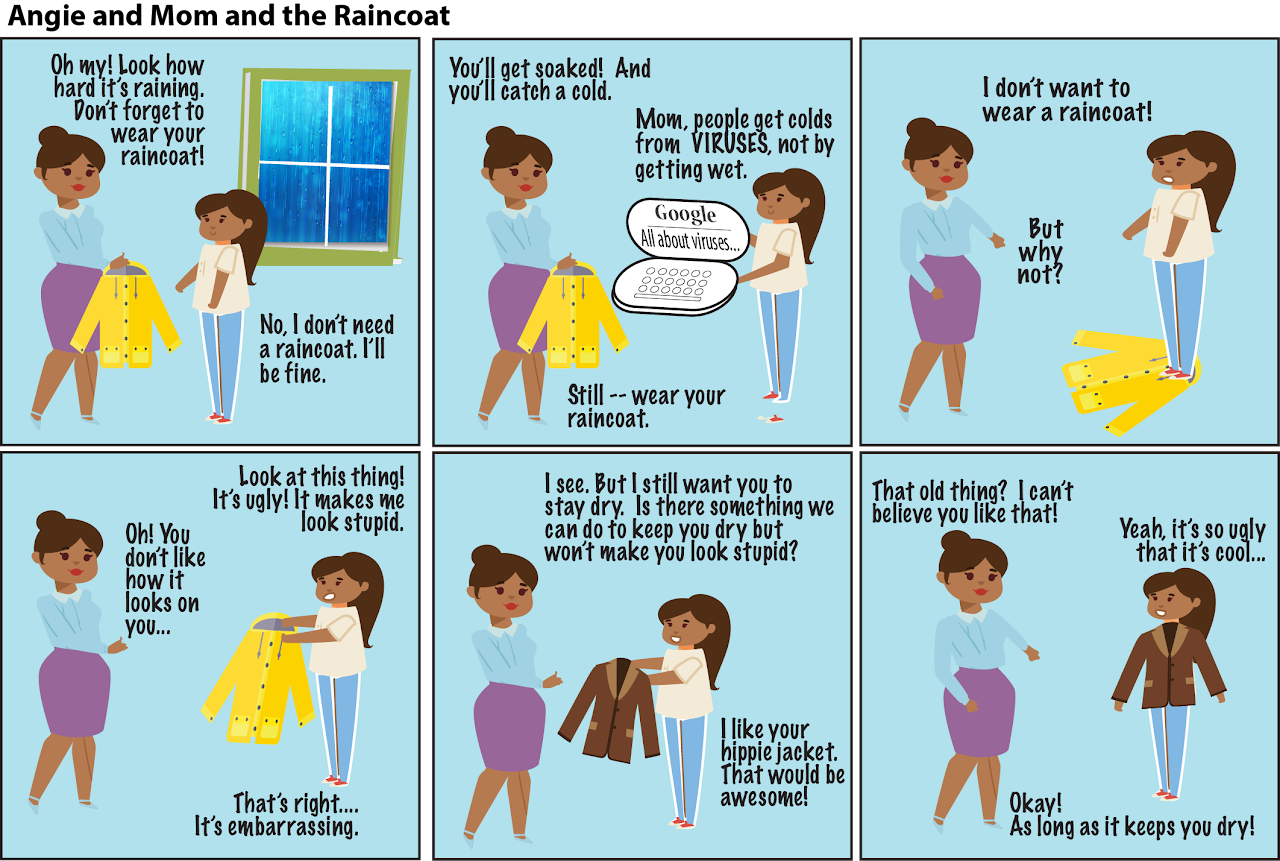
Now, let’s unpack this.
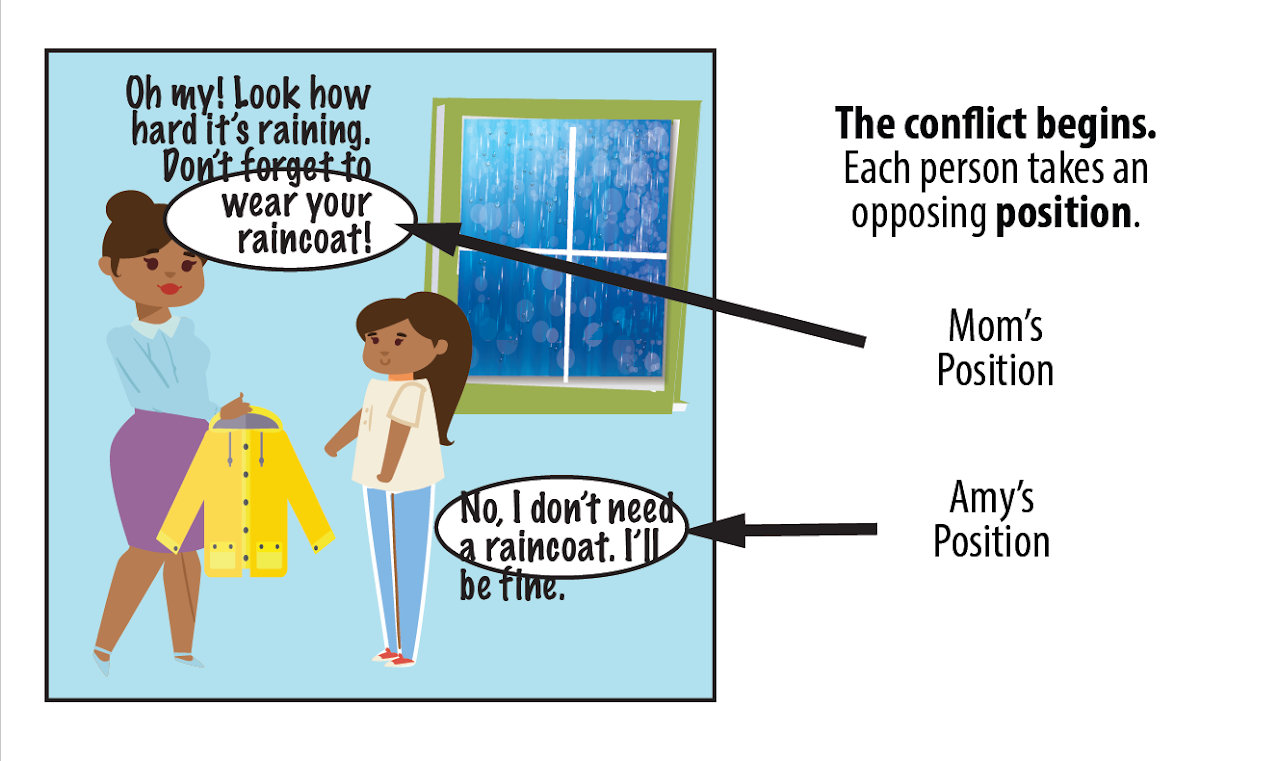
In the first panel, Mom and Amy take different “sides” or “positions”. Mom wants Amy to wear a raincoat, but Amy doesn’t want to wear it.
As long as the discussion stays on the level of “positions”, the conflict will reduce to a battle of wills. Each party will tend to assert her position, hoping the other will give in, and vice-versa.
When this happens, the person with the most power tends to win. And when that happens, there is resentment, anger and bad feelings. And those feelings tend to last a long time.
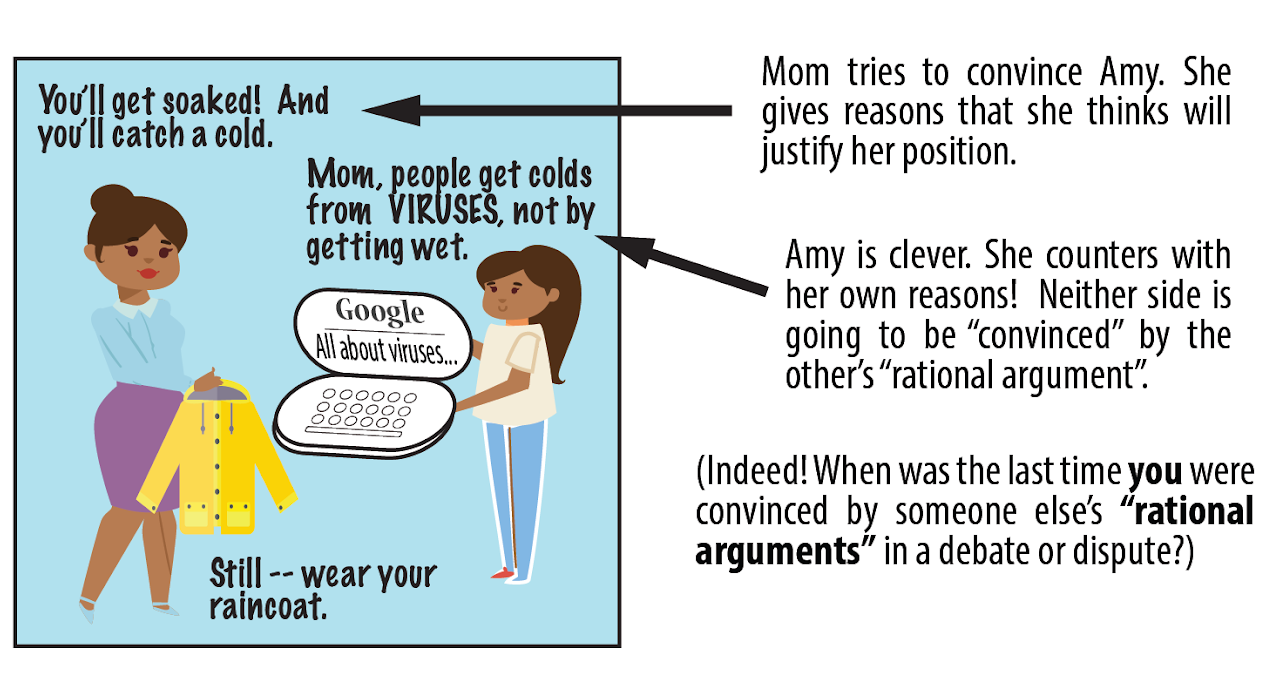
As they debate the issue, each side tries to “convince” the other. What do we do when two people adopt different positions? Well, we try to convince the other person that we are right and they are wrong.
We offer reasons, rationales and logic in order to convince the other person to change their position.
Really — when you are in a debate, when was the last time you changed your position because of something that the other person said? When were you convinced by the other?
Convincing doesn’t tend to work unless both parties are willing to be convinced!
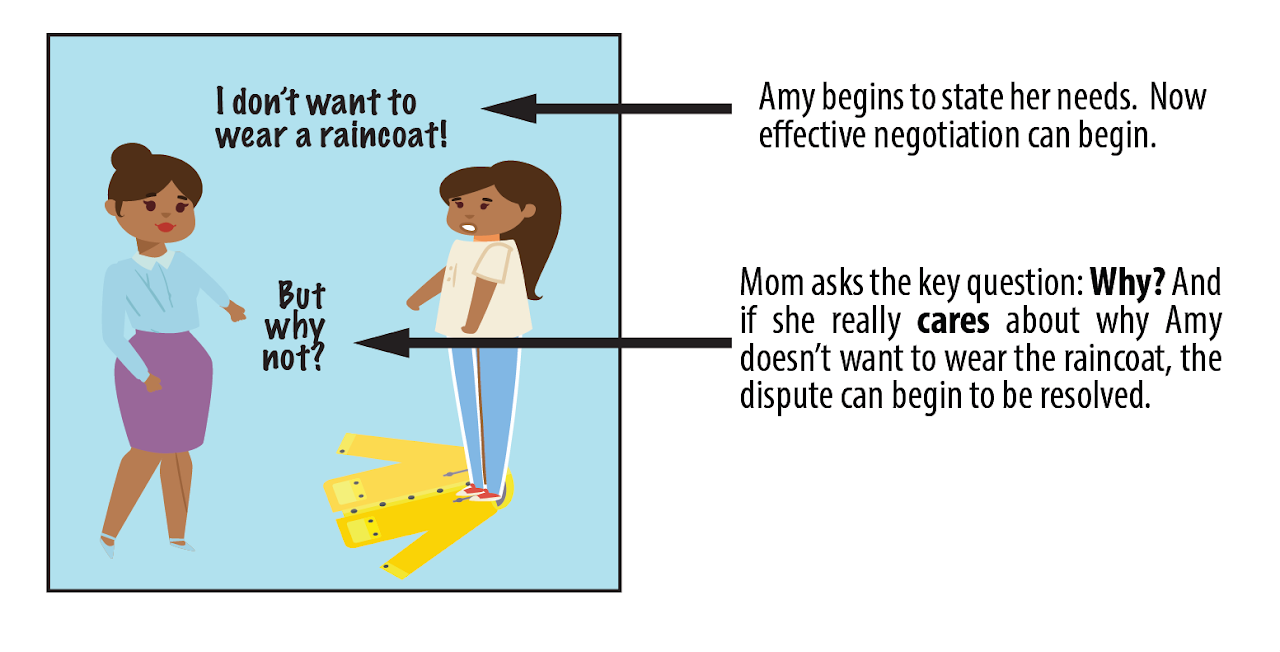
People act in order to meet their needs. Beneath every position, there is usually an unmet need. Find the need and you can begin to solve the problem.
The best way to begin to identify the needs that motivate a person’s position (including one’s own) is to ask “Why?” In this case, “Why don’t you want to wear the raincoat?” (If the other person answers by saying, “because I won’t get wet” or “I’m trying to save you the money of buying me a raincoat” — you know they’re trying to fool you. They are telling you what they think you want to hear rather than stating their genuine needs.
You have to make the other person feel safe enough to express themselves if you want to identify genuine needs.
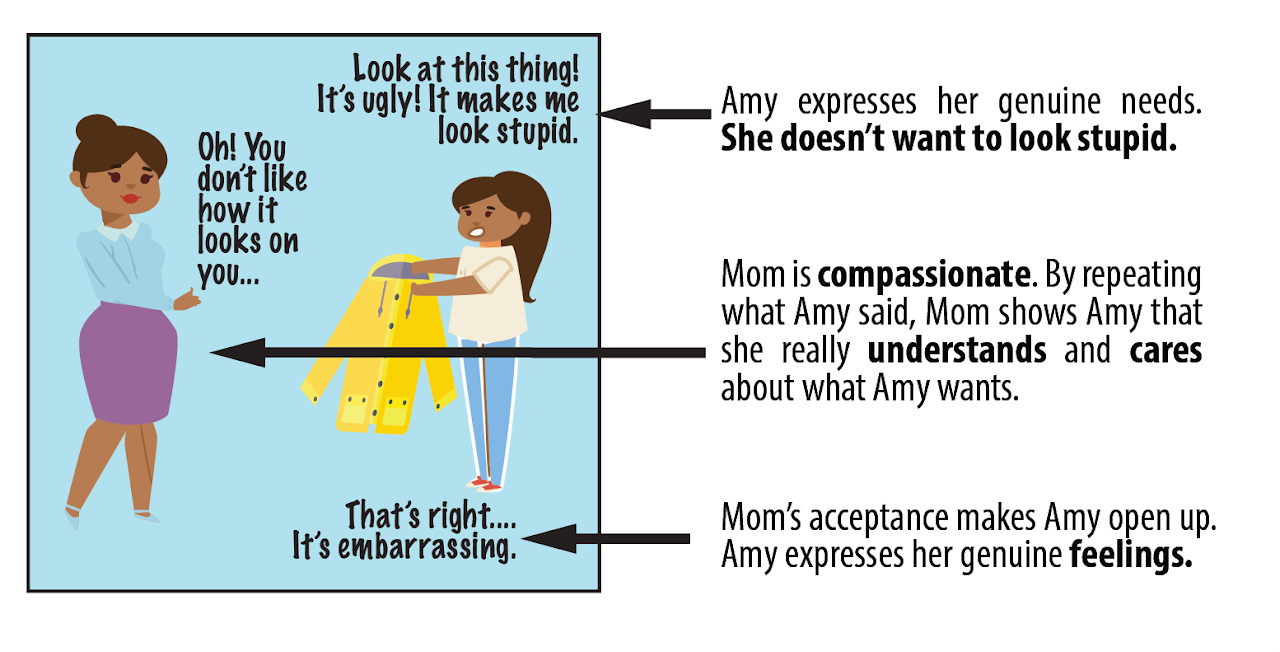
To identify someone’s needs, act with compassion, curiosity, and care. In this situation, Mom acted with compassion toward Amy by summarizing what Amy said. Once Amy began to sense that Mom truly cared about what Amy wanted — that Mom genuinely wanted to try to meet Amy’s genuine needs, Amy began to open up. She could now say, “I don’t want to look stupid!”
The trick to in much conflict resolution is to see that the needs that motivate each person’s initial positions are often not incompatible. Amy’s desire to “not look stupid” is not incompatible with Mom’s desire to “keep Amy dry”. Once Mom and Amy are able understand the deeper and more genuine needs, they can begin to look for ways to meet both sets of needs at the same time!
Panel 5
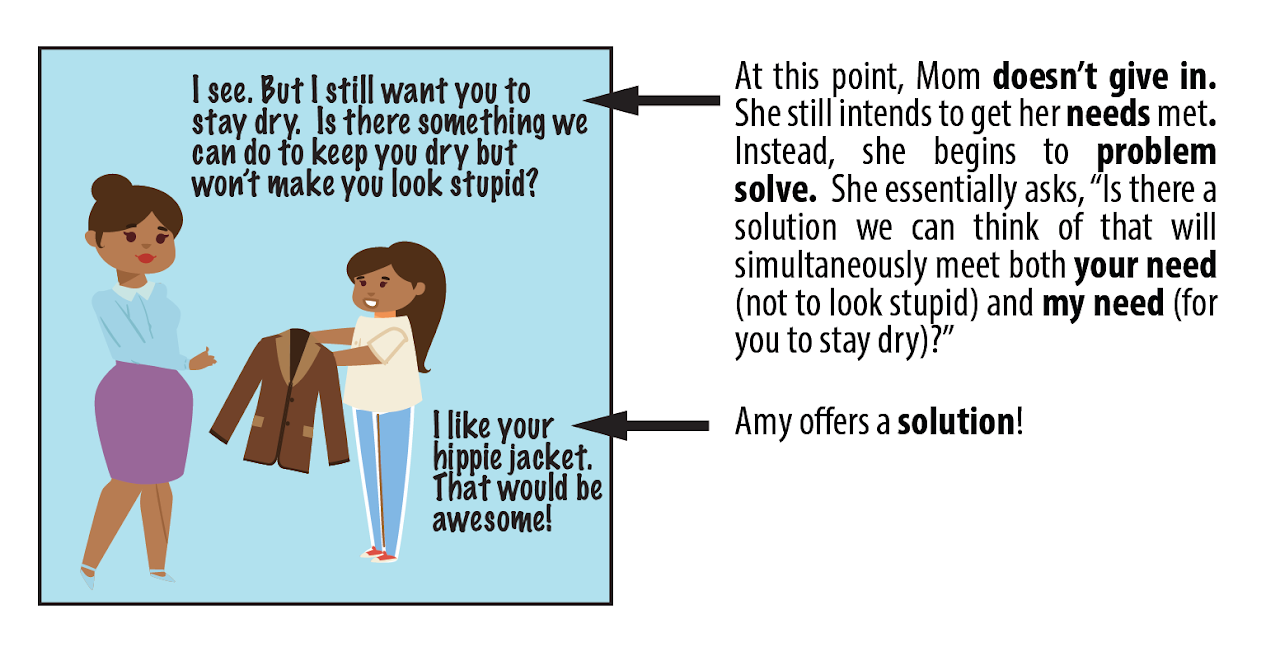
Meet the needs of each party. Now that we know that Mom wants to keep Amy dry and Amy wants to look “cool”, we can now engage in some genuine collaborative problem solving. How can we meet both sets of needs at the same time?
Conflict management typically requires two skills that people often see as incompatible — seeking to understand and meet the needs of the other while simultaneously not giving in on one’s own core needs. While initial positions in a dispute may clash, so often, when we identify the underlying needs that motivate those positions, we find that the needs themselves do not clash.
The task then becomes one of creating novel solutions to the problem of meeting each party’s needs.
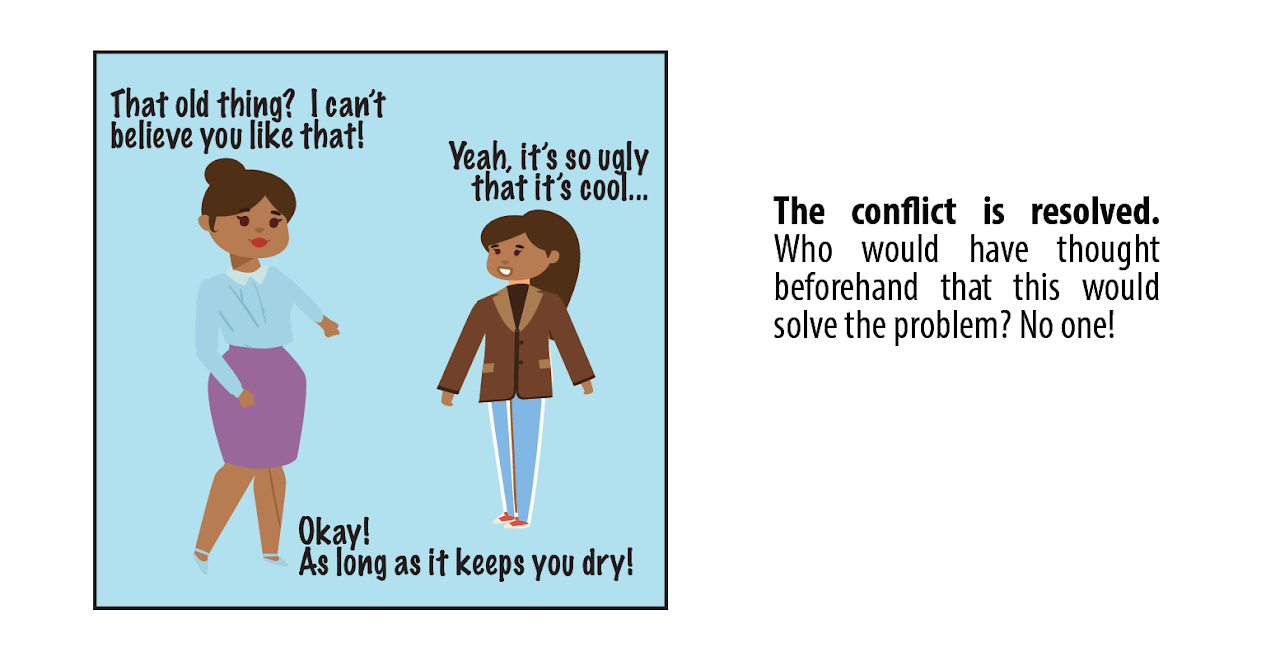
Common ground is created — not simply “found”. We often think of conflict resolution using the idea of “finding common ground”. The idea is that we start off on different pieces of ground, and if we search hard enough, we will find a piece of already existing land that we both share or can share.
But when people differ, “common ground” isn’t simply “found” — it has to be created. We literally have to invent it. Before Mom and Amy began to identify their needs, neither could have anticipated that Amy would be wearing Mom’s old hippie coat to school. That solution was created — it didn’t exist before Mom and Amy invented it.
The Language of Needs, Feelings and Observations

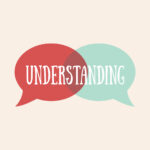
How we speak to each other when we find ourselves in conflict is important.
Perhaps the single greatest obstacle to managing conflict successfully is the tendency for people to attack each other. Anger, frustration and the desire to attack are natural reactions when we feel that other people are responsible for blocking our goals. However, anger causes defensiveness, which causes more anger. Soon we find ourselves in a vicious cycle of attack and counter-attack.
This doesn’t solve problems. It exacerbates them.
How we speak to each other when we find ourselves in conflict is important. Let’s talk about how the Language of Needs, Feelings and Observations provides an alternative to the Language of Blame and Criticism when we are trying to manage conflict.
The Language of Blame and Criticism
When people disagree, despite their best intentions, they tend to engage in a kind of battle. They take positions. They debate. They try to convince each other of who is right and who is wrong. Such discussions are rarely effective. After all, when was the last time that you changed your mind in a debate – especially about an issue about which you felt strongly?
In an argument, people often use the Language of Blame and Criticism:
You are not doing a good job.
That’s no way to run a meeting.
His sloppy report was the reason we didn’t get the funding.
She is such a tyrant!
They have no social skills.
These phrases blame, criticize and characterize. They blame when they indicate that someone is responsible for some bad outcome (e.g., “You are the reason we didn’t get funding.”). They criticize when they call the dignity of another person into question (e.g., “You are not doing a good job”). They characterize when they use language that casts a person or event in a particular way – usually a way that serves ones’ own agenda (e.g., “tyrant,” “sloppy”).
This approach doesn’t solve problems. Instead, blame and criticism cause defensiveness. Defensiveness creates more blame and criticism. Then the conflict escalates.
Solving Problems Together: Four Steps
We can use four basic steps to solve problems together:
Empathic Listening
When people take positions in a dispute, they are essentially trying to win an argument. One person attacks, the other person defends. The second person then makes her own attack, which is defended by the first. When this happens, each person’s need for dignity is typically violated. Neither party feels acknowledged or heard. The conflict escalates; the parties consider one another opponents rather than partners; and the problem remains unsolved.
Fortunately, people can continue seeing one another as partners rather than opponents when approached with empathy. People want to be heard. They want to be acknowledged. They want to know that their needs and feelings matter. The best way to show your partner that their needs matter is to show genuine empathy.
Practical Suggestions
To practice empathetic listening, you may use the following steps. When your partner is speaking – even if they are using the Language of Blame and Criticism – listen carefully to what the other person is saying. Don’t interrupt. Don’t defend yourself. Don’t try to convince the other person of anything. Don’t debate. Instead:
Even when we disagree with another person’s stated position, we can still care about their needs and feelings. Here are some examples of empathic listening when someone is not communicating with you at their best:
Tim: When I come home and see the dishes in the sink, I get so angry. You are so disrespectful! Don’t you know how hard I work all day? I’m your roommate – not your maid: Wash your own dishes.
Jose: I see that you are feeling angry that I left dishes in the sink. You are upset because you are feeling that I’m being disrespectful to you by not cleaning up after myself. You have a need for me to respect and care about what you want — am I understanding you correctly?
John: What’s the matter with you? You can’t expect me to give the boss a report if you don’t tell me what you want in the report! You have to do a better job communicating.
Tony: It sounds like you are upset with me because you have a need for clear communication and I didn’t email you my thoughts about the report – is that right?
Barbara: Don’t criticize my report in front of the group. I worked hard on that report. The figures you wanted weren’t in there because you didn’t ask for them.
Nancy: It seems like you are feeling embarrassed when I told the group that your report didn’t have the latest figures. I didn’t meet your need for dignity in front of the group – is that right?
Expressing Ourselves in the Language of Needs and Feelings
The most important step in the process is speaking in the Language of Needs and Feelings. To do this, instead of blaming, criticizing, complaining, convincing, or debating, tell your story. It might be good to think of your story as a “micro-story” – a short story in which you do the following:
An observation is a description of a particular event. An observation is not a generalization (e.g., You are always late with your reports”) or a characterization (e.g., “You are unreliable”). It is a description of the concrete aspects (i.e., what you can see or hear) of a particular event (e.g., “I see that you turned in your report on Friday when it was due on Monday.”)
A feeling is expressed by an emotion word (e.g., “frustrated,” “disappointed,” “sad,” “embarrassed,” “confused”). You can find a list of feeling words at the end of this pamphlet.
A need is something that you want or desire – what you care about deep down. You can find a list of needs at the end of this pamphlet.
Practical Suggestions
Here are some examples of micro-stories told in the Language of Needs and Feelings.
Last week, we talked about how your last report was late. We agreed that you would turn in your next report on Monday. I see that you turned in your report on Friday. This makes me feel frustrated, because I have a need for punctuality and cooperation.
As you know, I had to get to my interview today at 12:00. I had asked you to pick me up at 11:30. You arrived at 11:45. As a result, I was late for my interview. While I am grateful that you were willing to pick me up, I feel angry because I needed to be on time for my interview. I am disappointed because I have a need to be able to rely on you when you agree to do something.
Today, when I came home, I saw dishes in the sink. Last night, I washed all the dishes and put them away. When I see dishes in the sink, I feel anxious because I have a need for the house to be clean.
At our meeting today, you told the group that we had to take fewer breaks so that we can increase our sales. However, this week, our group has been working through our lunch breaks. When you said this, I felt resentful, because I have a need for our work to be acknowledged.
When you called the waiter over by snapping your fingers, I felt embarrassed because I have a need to make the work staff feel appreciated.
You gave an informative presentation today that covered the important points. You were able to remember each detail because you used your PowerPoint. However, when you were reading off your PowerPoint, my attention began to wane. I think some people felt disconnected from the presentation because they have a need to be emotionally engaged.
In each of these “micro-stories,” after making a concrete observation, the speaker expressed how the event in question made them feel, and linked this feeling to an unmet need. By pointing to one’s needs and feelings rather than criticizing aspects of the other person, the other becomes less defensive and more likely to hear your needs.
Moving Toward Healing Solutions
We often hear people say that we have to “find” common ground. This makes it sound as if “common ground” already exists somewhere – and we simply have to “find it”. However, in a conflict, there tends to be little already existing common ground. It is as if people are standing on their own individual islands – surrounded by water. In such a situation, one cannot really “find” common; it has to be created. We have to invent it. We must actively build it. This means we have to work together to build bridges – or even create new lands – that exist between our individual islands. This can happen if we have the compassion and care needed to work together in an attempt to solve each other’s problems.


If you like what we are doing, please support us in any way that you can.
Admin will contact you within 24 hours